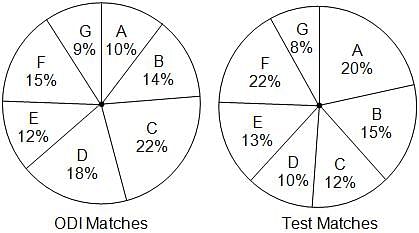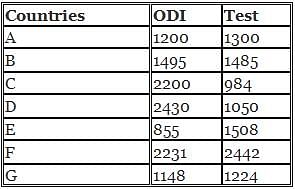CAT Exam > CAT Questions > Directions: Study the following pie-charts an...
Start Learning for Free
Directions: Study the following pie-charts and table carefully and answer accordingly.
The following pie charts show the number of wickets taken by a bowler against different countries in ODI and Test Matches.
Total number of wickets taken by the bowler in ODI and Test matches is 500 and 400, respectively.

The following table shows the number of runs conceded against different countries in ODI and Test Matches.

The following pie charts show the number of wickets taken by a bowler against different countries in ODI and Test Matches.
Total number of wickets taken by the bowler in ODI and Test matches is 500 and 400, respectively.

The following table shows the number of runs conceded against different countries in ODI and Test Matches.

Note: Strike rate of a bowler is defined as the runs conceded per wicket.
Q. Against which two countries did the bowler take the same numbers of wickets in ODI and Test Matches, respectively?
- a)B(ODI), F(Test)
- b)E(ODI), B(Test)
- c)F(ODI), B(Test)
- d)D(ODI), G(Test)
Correct answer is option 'B'. Can you explain this answer?
Most Upvoted Answer
Directions: Study the following pie-charts and table carefully and ans...
Here, E(ODI) = 12% of 500

And, B(Test) = 15% of 40

This option is correct.

And, B(Test) = 15% of 40

This option is correct.

|
Explore Courses for CAT exam
|

|
Similar CAT Doubts
Directions: Study the following pie-charts and table carefully and answer accordingly.The following pie charts show the number of wickets taken by a bowler against different countries in ODI and Test Matches.Total number of wickets taken by the bowler in ODI and Test matches is 500 and 400, respectively.The following table shows the number of runs conceded against different countries in ODI and Test Matches.Note: Strike rate of a bowler is defined as the runs conceded per wicket.Q.Against which two countries did the bowler take the same numbers of wickets in ODI and Test Matches, respectively?a)B(ODI), F(Test)b)E(ODI), B(Test)c)F(ODI), B(Test)d)D(ODI), G(Test)Correct answer is option 'B'. Can you explain this answer?
Question Description
Directions: Study the following pie-charts and table carefully and answer accordingly.The following pie charts show the number of wickets taken by a bowler against different countries in ODI and Test Matches.Total number of wickets taken by the bowler in ODI and Test matches is 500 and 400, respectively.The following table shows the number of runs conceded against different countries in ODI and Test Matches.Note: Strike rate of a bowler is defined as the runs conceded per wicket.Q.Against which two countries did the bowler take the same numbers of wickets in ODI and Test Matches, respectively?a)B(ODI), F(Test)b)E(ODI), B(Test)c)F(ODI), B(Test)d)D(ODI), G(Test)Correct answer is option 'B'. Can you explain this answer? for CAT 2025 is part of CAT preparation. The Question and answers have been prepared according to the CAT exam syllabus. Information about Directions: Study the following pie-charts and table carefully and answer accordingly.The following pie charts show the number of wickets taken by a bowler against different countries in ODI and Test Matches.Total number of wickets taken by the bowler in ODI and Test matches is 500 and 400, respectively.The following table shows the number of runs conceded against different countries in ODI and Test Matches.Note: Strike rate of a bowler is defined as the runs conceded per wicket.Q.Against which two countries did the bowler take the same numbers of wickets in ODI and Test Matches, respectively?a)B(ODI), F(Test)b)E(ODI), B(Test)c)F(ODI), B(Test)d)D(ODI), G(Test)Correct answer is option 'B'. Can you explain this answer? covers all topics & solutions for CAT 2025 Exam. Find important definitions, questions, meanings, examples, exercises and tests below for Directions: Study the following pie-charts and table carefully and answer accordingly.The following pie charts show the number of wickets taken by a bowler against different countries in ODI and Test Matches.Total number of wickets taken by the bowler in ODI and Test matches is 500 and 400, respectively.The following table shows the number of runs conceded against different countries in ODI and Test Matches.Note: Strike rate of a bowler is defined as the runs conceded per wicket.Q.Against which two countries did the bowler take the same numbers of wickets in ODI and Test Matches, respectively?a)B(ODI), F(Test)b)E(ODI), B(Test)c)F(ODI), B(Test)d)D(ODI), G(Test)Correct answer is option 'B'. Can you explain this answer?.
Directions: Study the following pie-charts and table carefully and answer accordingly.The following pie charts show the number of wickets taken by a bowler against different countries in ODI and Test Matches.Total number of wickets taken by the bowler in ODI and Test matches is 500 and 400, respectively.The following table shows the number of runs conceded against different countries in ODI and Test Matches.Note: Strike rate of a bowler is defined as the runs conceded per wicket.Q.Against which two countries did the bowler take the same numbers of wickets in ODI and Test Matches, respectively?a)B(ODI), F(Test)b)E(ODI), B(Test)c)F(ODI), B(Test)d)D(ODI), G(Test)Correct answer is option 'B'. Can you explain this answer? for CAT 2025 is part of CAT preparation. The Question and answers have been prepared according to the CAT exam syllabus. Information about Directions: Study the following pie-charts and table carefully and answer accordingly.The following pie charts show the number of wickets taken by a bowler against different countries in ODI and Test Matches.Total number of wickets taken by the bowler in ODI and Test matches is 500 and 400, respectively.The following table shows the number of runs conceded against different countries in ODI and Test Matches.Note: Strike rate of a bowler is defined as the runs conceded per wicket.Q.Against which two countries did the bowler take the same numbers of wickets in ODI and Test Matches, respectively?a)B(ODI), F(Test)b)E(ODI), B(Test)c)F(ODI), B(Test)d)D(ODI), G(Test)Correct answer is option 'B'. Can you explain this answer? covers all topics & solutions for CAT 2025 Exam. Find important definitions, questions, meanings, examples, exercises and tests below for Directions: Study the following pie-charts and table carefully and answer accordingly.The following pie charts show the number of wickets taken by a bowler against different countries in ODI and Test Matches.Total number of wickets taken by the bowler in ODI and Test matches is 500 and 400, respectively.The following table shows the number of runs conceded against different countries in ODI and Test Matches.Note: Strike rate of a bowler is defined as the runs conceded per wicket.Q.Against which two countries did the bowler take the same numbers of wickets in ODI and Test Matches, respectively?a)B(ODI), F(Test)b)E(ODI), B(Test)c)F(ODI), B(Test)d)D(ODI), G(Test)Correct answer is option 'B'. Can you explain this answer?.
Solutions for Directions: Study the following pie-charts and table carefully and answer accordingly.The following pie charts show the number of wickets taken by a bowler against different countries in ODI and Test Matches.Total number of wickets taken by the bowler in ODI and Test matches is 500 and 400, respectively.The following table shows the number of runs conceded against different countries in ODI and Test Matches.Note: Strike rate of a bowler is defined as the runs conceded per wicket.Q.Against which two countries did the bowler take the same numbers of wickets in ODI and Test Matches, respectively?a)B(ODI), F(Test)b)E(ODI), B(Test)c)F(ODI), B(Test)d)D(ODI), G(Test)Correct answer is option 'B'. Can you explain this answer? in English & in Hindi are available as part of our courses for CAT.
Download more important topics, notes, lectures and mock test series for CAT Exam by signing up for free.
Here you can find the meaning of Directions: Study the following pie-charts and table carefully and answer accordingly.The following pie charts show the number of wickets taken by a bowler against different countries in ODI and Test Matches.Total number of wickets taken by the bowler in ODI and Test matches is 500 and 400, respectively.The following table shows the number of runs conceded against different countries in ODI and Test Matches.Note: Strike rate of a bowler is defined as the runs conceded per wicket.Q.Against which two countries did the bowler take the same numbers of wickets in ODI and Test Matches, respectively?a)B(ODI), F(Test)b)E(ODI), B(Test)c)F(ODI), B(Test)d)D(ODI), G(Test)Correct answer is option 'B'. Can you explain this answer? defined & explained in the simplest way possible. Besides giving the explanation of
Directions: Study the following pie-charts and table carefully and answer accordingly.The following pie charts show the number of wickets taken by a bowler against different countries in ODI and Test Matches.Total number of wickets taken by the bowler in ODI and Test matches is 500 and 400, respectively.The following table shows the number of runs conceded against different countries in ODI and Test Matches.Note: Strike rate of a bowler is defined as the runs conceded per wicket.Q.Against which two countries did the bowler take the same numbers of wickets in ODI and Test Matches, respectively?a)B(ODI), F(Test)b)E(ODI), B(Test)c)F(ODI), B(Test)d)D(ODI), G(Test)Correct answer is option 'B'. Can you explain this answer?, a detailed solution for Directions: Study the following pie-charts and table carefully and answer accordingly.The following pie charts show the number of wickets taken by a bowler against different countries in ODI and Test Matches.Total number of wickets taken by the bowler in ODI and Test matches is 500 and 400, respectively.The following table shows the number of runs conceded against different countries in ODI and Test Matches.Note: Strike rate of a bowler is defined as the runs conceded per wicket.Q.Against which two countries did the bowler take the same numbers of wickets in ODI and Test Matches, respectively?a)B(ODI), F(Test)b)E(ODI), B(Test)c)F(ODI), B(Test)d)D(ODI), G(Test)Correct answer is option 'B'. Can you explain this answer? has been provided alongside types of Directions: Study the following pie-charts and table carefully and answer accordingly.The following pie charts show the number of wickets taken by a bowler against different countries in ODI and Test Matches.Total number of wickets taken by the bowler in ODI and Test matches is 500 and 400, respectively.The following table shows the number of runs conceded against different countries in ODI and Test Matches.Note: Strike rate of a bowler is defined as the runs conceded per wicket.Q.Against which two countries did the bowler take the same numbers of wickets in ODI and Test Matches, respectively?a)B(ODI), F(Test)b)E(ODI), B(Test)c)F(ODI), B(Test)d)D(ODI), G(Test)Correct answer is option 'B'. Can you explain this answer? theory, EduRev gives you an
ample number of questions to practice Directions: Study the following pie-charts and table carefully and answer accordingly.The following pie charts show the number of wickets taken by a bowler against different countries in ODI and Test Matches.Total number of wickets taken by the bowler in ODI and Test matches is 500 and 400, respectively.The following table shows the number of runs conceded against different countries in ODI and Test Matches.Note: Strike rate of a bowler is defined as the runs conceded per wicket.Q.Against which two countries did the bowler take the same numbers of wickets in ODI and Test Matches, respectively?a)B(ODI), F(Test)b)E(ODI), B(Test)c)F(ODI), B(Test)d)D(ODI), G(Test)Correct answer is option 'B'. Can you explain this answer? tests, examples and also practice CAT tests.

|
Explore Courses for CAT exam
|

|
Signup for Free!
Signup to see your scores go up within 7 days! Learn & Practice with 1000+ FREE Notes, Videos & Tests.
























